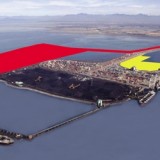We’ve known it all along, but at last we hear it out loud. Robin Silvester, the President and CEO of Port Metro Vancouver, has stated that:
“Agriculture is emotionally important, but economically [of] relatively low importance to the Lower Mainland. And in terms of food security, [it] is almost meaningless for the Lower Mainland.”
So there we have it…finally, honesty from someone in a position of power. Our Premiers and their governments have known it was too political to admit to — that Delta’s agricultural land will be turned into an industrial park.
And to put the icing on Delta’s cake, so to speak, the Premier commented at a recent dinner to the construction industry that those silly people in Delta don’t want the Port: how unpatriotic can they be? Look at the jobs, the opportunity to be “Canada’s face to Asia,” to contribute to the good of the province and of Canada!
Well, Madam Premier, we know the value of Deltaport to BC and to Canada. We live with it. We accept its presence. And we have given up more than you can imagine in order to host the port, as well as its access roads, its rail tracks, the overpasses, the highways and the causeways it requires to operate efficiently.
We have contributed to the economic prosperity of our country and region. And enough is enough. Credible alternatives are available in Vancouver harbor and at Prince Rupert so it is irresponsible to destroy more farmland and internationally-significant habitat for world-renowned salmon runs, Canada’s major stopover for migratory birds of the Pacific Flyway, and endangered southern resident orcas.
Now we know that the Premier and her industrial supporters intend to lay waste to what is left of the Fraser estuary. Now we know that any obligation to community, to family, to history, to wildlife (both marine and avian) migrations, to the finest agricultural land in Canada, is not on the provincial agenda. Habitat and farmland are being sacrificed for business and a plan that could ultimately be unfeasible. This is also about rezoning farmland, a lucrative enterprise for the business associates of government.
Many of those fighting to preserve what is left of Delta’s agricultural heritage and the migratory bird flyway that depends on those uplands have known that government policies supported Silvester’s position. It has been clear from its reports that the Gateway Council controls the government agenda. But to hear the comment finally spoken aloud is still a jarring experience.
Yes, Mr. Silvester, it is emotional. Our community – our families, our history, our agricultural industry, our soul and our quality of our life depend on the land. So does the entire Pacific population of migrating waterfowl and shorebirds. But the people don’t matter. Nor does wildlife or the morality of protecting an international Treaty obligation to preserve the habitat on which that migration depends.
The people of B.C. recognize the importance of credible business and trade but question the motives of unnecessarily destroying the environment and fine agricultural land.
We deserve a say in the decisions that affect our communities and lives. Does anyone else feel there is a reason people are occupying Wall Street?
Vicki Huntington is the Independent BC MLA for Delta South and a contributor to The Common Sense Canadian




 At one time, a single farm run by Lynda and Larry Peterson provided a quarter of the region’s potatoes and a market garden with fresh fruits and vegetables of a wide variety.
At one time, a single farm run by Lynda and Larry Peterson provided a quarter of the region’s potatoes and a market garden with fresh fruits and vegetables of a wide variety.
